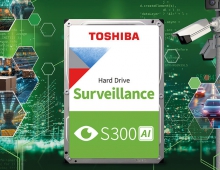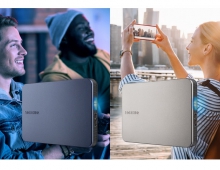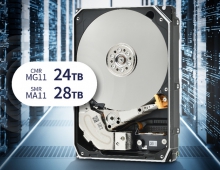Testing Toshiba's Storage devices: FlashAir W-04, TransMemory U363 and U364 flash drives
1. FlashAir W-04 - SD Card with Wi-Fi connectivity
Review Pages
2. Toshiba U363 and U364 TransMemory USB 3.0 flash drives
Today we are taking a look at three flash storage products by Toshiba - the 4th generation FlashAir, the 64GB Transmemory U363 USB 3.0 memory stick and the tiny, 64GB TransMemory USB 3.0 flash drive.
- The next generation of the Toshiba's FlashAir wireless SD card technology is packed onto the FlashAir W-04, a standard SD memory card equipped with wireless connection functionality. Built-in wireless LAN functionality allows data stored on the card to be transferred to external devices such as PCs, smartphones and tablets. According to Toshiba, New for the 4th generation FlashAir SD card is a new processor design and an enhanced wireless performance.
- The 64GB Transmemory U363 USB 3.0 memory stick is compact enough to be attached to car keys. It is housed in a protecting metal body and promises to offer a read speed of 120MB/s.
- The TransMemory USB 3.0 Flash Drive, which combines big capacities and a maximum read transfer speed of 120MB/s into the smallest, most discrete USB stick yet.
FlashAir W-04
Showcased at last year's CeBIT event, the 4th generation FlashAir is an upgraded version of Toshiba's FlashAir series, armed with a new processor and enhanced wireless performance.
Compatible with the UHS-I standard, the device offers UHS speed class 3 to support 4K video recording. Toshiba says that the device's maximum read and write performance is 90MB/s and 70MB/s respectively. Its qouted wireless LAN performance is about 31.4Mbps, which is more than twice the performance of theToshiba's 3rd generation FlashAir.
In addition, the FlashAir W-04 offers an integrated 'Eyefi Connected' feature that prevents a camera automatically powering off when wirelessly connecting with FlashAir.
As well as Toshiba's own FlashAir application, the latest FlashAir cards also work with Ricoh Innovations Corporation's 'Keenai' photo storage and management service. Keenai allows the automatic transfer of photo data from FlashAir cards and enables users to autosync photo and movie data to the cloud.
The new FlashAir cards are available with capacities of 16GB ($40), 32GB ($45) and 64GB ($72).
| THN-NW04W0160E6 | THN-NW04W0320E6 | THN-NW04W0640E6 | |
| Capacity | 16GB | 32GB | 64GB |
| Speed Class | UHS–I Speed Class 3 | ||
| Read Speed | 90 MB/s | ||
| Write Speed | 70 MB/s | ||
| Wireless Transfer Speed | Max : 100Mbps (60~70Mbps@Camera inserted) | ||
| Wireless LAN Standard | IEEE802.11 b/g/n (2.4GHz SISO,20MHz) | ||
| Wireless LAN Security | WEP, TKIP, AES (WPA, WPA2) | ||
| DSC (Digital Still Camera) | Compatible with SDHC Memory Card | ||
| Operating System (for config.) | Windows Vista/7/8/8.1/10 Mac OS X V.10.7 to V.10.10 | ||
| Browser | Internet Explorer, Safari, etc | ||
| App V.3.1.1 for Android devices | Android OS V.2.3.3 to V.5.0, Smartphone and Tablet are supported | ||
| App V.3.1.1 for iOS devices | iOS V.6.0 ~, iPhone and iPad are supported | ||
| Applicable Data Formats | All data formats (ex: .jpg, .mpg, .raw etc) | ||
| Power Supply | 2.7 - 3.6V | ||
| Dimensions | 32.0mm(L)x24.0mm(W)x2.1mm(T) | ||
| Weight | approx. 2 g | ||
| Operating Temperature | -25°C to +85°C (Recommended) | ||
| Storage Temperature | -40°C to +85°C (Recommended) | ||
The 16GB FlashAir W-04 we have in our hands retails in the package you see below, in which will find a multi-language manual and the SD card.



Why buying the FlashAir W-04? Well, its basic feature is that it works as a stand alone Wireless LAN access point, meaning it can both wirelessly send files and receive files. And of course, it retains the normal functionality of an SD card, allowing general Wi-Fi devices like PCs and smartphones to access its contents. You may think that modern cameras have a built-in Wi-Fi functionality. This makes the FlashAir concept a bit outdated, but still there are certainly some of you out there with cameras that are of a few years old, and the FlashAir W-04 comes to provide you the convenience of wireless transfers.
In order to use the card you can just pop it your camera. The card is actually powered by the camer itselfa, but its power consumption is low, as we did not notice our camera's battery to drain faster than normal. Connect to the wi-fi network that will appear using the default '12345678' password.
The next thing to do is to download the FlashAir app from the Apple app store or Google Play, depending on your device. Once installed, the app will find your FlashAir card and link it.
The app is simple and easy to use. It will start downloading the previews of the images, although any RAW files don't show a preview. JPEGs will appear in a small preview, which becomes bigger once you click it. Your images will appear on a grid and you can either choose to download single images or download all of the images at once. A standard 'Share' icon allows you to share images directly to Facebook or Twitter, or via email.
Through the app, you can also enable Internet passthrough, allowing the FlashAir card to connect to your home wi-fi network. This means that you can still access the internet on your device whilst using the card. Thhe downside here is that the card can only store the details for one wi-fi network, so you have to type this in manually. In addition, we could not access the card's content via our existing home wi-fi network.
Keep in mind is that you can't format the FlashAir with your camera or PC because you will delete the FlashAir software on the card. That will cause the card to lose its Wi-Fi connectivity. But if you still need to format it, you may download the FlashAir utility and reinstall the software. You can also use that app to format the card without breaking the Wi-Fi functionality.
In terms of wireless transfer speeds, we cannot say that the FlashAir W-04 was fast. Of course, the Wi-Fi speed is generally influenced by the Wi-Fi receiver you use, the type of camera and the distance between your camera and the receiver. For a wireless transfer between our camera and a Samsung Galaxy S7 smartphone, a 16 MB RAW image was tranfered in 5 seconds, with the devices to be about 4 meters away from each other. This is translated to a wireless transfer speed of 3-4 MBps. The distamce between the two devices seems to be critical, as moving them further away resulted to an unstable wireless connection.
As an SD Card, the FlashAir W-04 will perform very welll and its read and write transfer speeds are close to those quoted by Toshiba. Expect about 90MBps for read and 80MBps for write tasks, as you see in the benchmarks below. Of course, dealing with small files will result in lower speeds.
These speeds make the Toshiba FlashAir W04 fast enough for all kinds of photography and filming up to HD resolution, although 4K video with lower bitrates will also work.


Photography enthusiasts may find the FlashAir a bit slow in terms of wireless transfer speeds. The average user will enjoy the convenience of Toshiba's FlashAir wireless connectivity, especially those who use older cameras.
PROS
- Capacity
- 5 Year Warranty
- Wifi connectivity - convenience
- Good performance as an SD Card
CONS
- Wifi Performance
Review Pages
2. Toshiba U363 and U364 TransMemory USB 3.0 flash drives





















